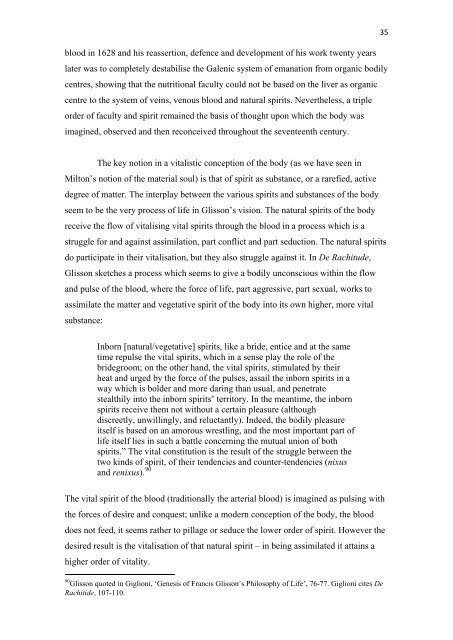Medical Science and the Anatomia Animata in Milton's Paradise Lost
Medical Science and the Anatomia Animata in Milton's Paradise Lost
Medical Science and the Anatomia Animata in Milton's Paradise Lost
Create successful ePaper yourself
Turn your PDF publications into a flip-book with our unique Google optimized e-Paper software.
lood <strong>in</strong> 1628 <strong>and</strong> his reassertion, defence <strong>and</strong> development of his work twenty years<br />
later was to completely destabilise <strong>the</strong> Galenic system of emanation from organic bodily<br />
centres, show<strong>in</strong>g that <strong>the</strong> nutritional faculty could not be based on <strong>the</strong> liver as organic<br />
centre to <strong>the</strong> system of ve<strong>in</strong>s, venous blood <strong>and</strong> natural spirits. Never<strong>the</strong>less, a triple<br />
order of faculty <strong>and</strong> spirit rema<strong>in</strong>ed <strong>the</strong> basis of thought upon which <strong>the</strong> body was<br />
imag<strong>in</strong>ed, observed <strong>and</strong> <strong>the</strong>n reconceived throughout <strong>the</strong> seventeenth century.<br />
The key notion <strong>in</strong> a vitalistic conception of <strong>the</strong> body (as we have seen <strong>in</strong><br />
Milton’s notion of <strong>the</strong> material soul) is that of spirit as substance, or a rarefied, active<br />
degree of matter. The <strong>in</strong>terplay between <strong>the</strong> various spirits <strong>and</strong> substances of <strong>the</strong> body<br />
seem to be <strong>the</strong> very process of life <strong>in</strong> Glisson’s vision. The natural spirits of <strong>the</strong> body<br />
receive <strong>the</strong> flow of vitalis<strong>in</strong>g vital spirits through <strong>the</strong> blood <strong>in</strong> a process which is a<br />
struggle for <strong>and</strong> aga<strong>in</strong>st assimilation, part conflict <strong>and</strong> part seduction. The natural spirits<br />
do participate <strong>in</strong> <strong>the</strong>ir vitalisation, but <strong>the</strong>y also struggle aga<strong>in</strong>st it. In De Rachitude,<br />
Glisson sketches a process which seems to give a bodily unconscious with<strong>in</strong> <strong>the</strong> flow<br />
<strong>and</strong> pulse of <strong>the</strong> blood, where <strong>the</strong> force of life, part aggressive, part sexual, works to<br />
assimilate <strong>the</strong> matter <strong>and</strong> vegetative spirit of <strong>the</strong> body <strong>in</strong>to its own higher, more vital<br />
substance:<br />
Inborn [natural/vegetative] spirits, like a bride, entice <strong>and</strong> at <strong>the</strong> same<br />
time repulse <strong>the</strong> vital spirits, which <strong>in</strong> a sense play <strong>the</strong> role of <strong>the</strong><br />
bridegroom; on <strong>the</strong> o<strong>the</strong>r h<strong>and</strong>, <strong>the</strong> vital spirits, stimulated by <strong>the</strong>ir<br />
heat <strong>and</strong> urged by <strong>the</strong> force of <strong>the</strong> pulses, assail <strong>the</strong> <strong>in</strong>born spirits <strong>in</strong> a<br />
way which is bolder <strong>and</strong> more dar<strong>in</strong>g than usual, <strong>and</strong> penetrate<br />
stealthily <strong>in</strong>to <strong>the</strong> <strong>in</strong>born spirits’ territory. In <strong>the</strong> meantime, <strong>the</strong> <strong>in</strong>born<br />
spirits receive <strong>the</strong>m not without a certa<strong>in</strong> pleasure (although<br />
discreetly, unwill<strong>in</strong>gly, <strong>and</strong> reluctantly). Indeed, <strong>the</strong> bodily pleasure<br />
itself is based on an amorous wrestl<strong>in</strong>g, <strong>and</strong> <strong>the</strong> most important part of<br />
life itself lies <strong>in</strong> such a battle concern<strong>in</strong>g <strong>the</strong> mutual union of both<br />
spirits.” The vital constitution is <strong>the</strong> result of <strong>the</strong> struggle between <strong>the</strong><br />
two k<strong>in</strong>ds of spirit, of <strong>the</strong>ir tendencies <strong>and</strong> counter-tendencies (nixus<br />
<strong>and</strong> renixus). 90<br />
The vital spirit of <strong>the</strong> blood (traditionally <strong>the</strong> arterial blood) is imag<strong>in</strong>ed as puls<strong>in</strong>g with<br />
<strong>the</strong> forces of desire <strong>and</strong> conquest; unlike a modern conception of <strong>the</strong> body, <strong>the</strong> blood<br />
does not feed, it seems ra<strong>the</strong>r to pillage or seduce <strong>the</strong> lower order of spirit. However <strong>the</strong><br />
desired result is <strong>the</strong> vitalisation of that natural spirit – <strong>in</strong> be<strong>in</strong>g assimilated it atta<strong>in</strong>s a<br />
higher order of vitality.<br />
90<br />
Glisson quoted <strong>in</strong> Giglioni, ‘Genesis of Francis Glisson’s Philosophy of Life’, 76-77. Giglioni cites De<br />
Rachitide, 107-110.<br />
35
















